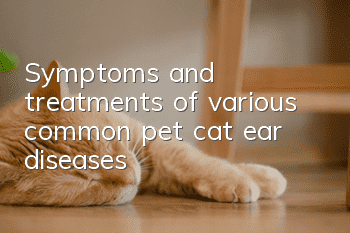Symptoms and treatments of various common pet cat ear diseases

Naughty, gentle and sometimes mischievous cats often have their ears troubled by diseases. Although they love to be clean and have high demands on themselves, because they like to hide their illnesses, owners must regularly Observe the condition of the cat’s ears. Below are the symptoms and treatment methods of various cat ear diseases compiled by Pet Cat Network. I hope it can help everyone.
1. Otitis media: Shaking the head, trying to touch the ears, tilting the head as much as possible and scratching the ears with the claws, it may be that the facial nerves are damaged, the lips are itchy, and the eyelid reflexes are slow. When the sympathetic nerves are damaged, the third eyelid (submembrane) of Horner's syndrome (a disorder caused by loss of sympathetic innervation) is more likely to protrude.
2. Otitis interna: Otitis interna develops from otitis media. Due to the damage to the vestibular organ responsible for the sense of movement and balance, eyeballs vibrate, making it impossible to master the sense of balance well and unable to walk steadily.
Treatment: Take antibiotics.
3. Foreign objects in the ears: If a foreign object enters the ear, the cat will pay attention to its ears.
4. Earwax: Otitis externa is formed due to infection by external parasites.
Diagnosis: Confirmation of external parasites under a microscope.
Treatment: Use parasite anthelmintics.
5. Trauma: Trauma caused by fighting between cats will lead to pus wounds. Due to pain in the injured area, cats will hate being touched by their ears. The common cause of cat injuries is avian cholera.
Treatment: Treat suppuration with antibiotics.
6. Lacerations and lacerations of the auricles: Fights or accidents between cats can cause partial damage or lacerations to the auricles.
Treatment: Surgery.
7. Bacterial otitis externa: Pathogenic bacteria: Staphylococcus enterotoxin, Streptococcus family, Pasteurella multocida toxin, Malassezia infection, etc.
8. Pseudomonas aeruginosa infectious otitis externa: One of the causes of suppurative otitis externa is Pseudomonas aeruginosa infection. Brown earwax appears from yellow earwax. As basic diseases, cats are easily infected with otitis externa during viral infections such as feline leukemia virus infection and HIV infection. It often happens that otitis externa is difficult to cure.
Treatment: Take antibiotics.
9. Ear hematoma: Cats suffering from otitis externa may scratch their ears, shake their heads, or rub their ears against other objects, causing injuries and causing ear hematoma. The ear hematoma involves a wide range of areas, and the auricles may droop.
10. Squamous epithelial cancer at the front of the auricle: When the ears are erect, a swollen lesion appears at the front of the auricle.
Treatment: Surgical resection
11. Tumors of the ear canal: Tumors may be the cause of otitis externa.One of the reasons.
Treatment: Once the tumor is identified, it must be surgically removed.
12. Polyps in the ear canal: Polyps in the ear canal can also cause ear canal inflammation.
Treatment: Once the polyps are confirmed, surgical removal is required.
13. Abnormalities of the tympanic membrane: The normal tympanic membrane is transparent with a cyan membrane. The diseased tympanic membrane has no sense of transparency and no feeling of tension and expansion. You can see the eardrum vibrating in waves. A ruptured eardrum may release a fluid substance. At this time, the cat will frequently shake its head. Due to chronic stimulation of the tympanic membrane, the tympanic membrane will develop lesions. Otitis externa or otitis media causes inflammation of the eardrum.
Treatment: Do not take antibiotics.
14. Deafness in white cats: As a genetic disease, there are some mutations. It is a disease that generally occurs in white cats. However, cats with deafness can carry out normal movements or actions, so they are not easily noticed. If the cat makes a sound behind the cat's ears without the cat noticing it, and the cat will not respond, or if the cat's ears vibrate and there is no auditory response, then you can tell that the cat is deaf. A cat with deaf ears will not respond. The tract is clean and the tympanic membrane is normal.
How to take care of cat ears: Use absorbent cotton to wrap your fingers and wipe the dirty areas. Do not insert cotton swabs into the ear holes of the ears, because the cat's ear holes are very thin, and inserting cotton swabs into the ear canal will injure the ear canal. Moreover, ear fat will flow out naturally, so inserting a cotton swab into the ear point will cause trouble.
15. Scabies in cats: Small perforated scabies in cats is the cause.
There are so many diseases that can occur in cats’ two small ears, and the symptoms of some diseases are very similar, so correct judgment is the prerequisite for successful treatment of ear diseases. In fact, most of the above ear diseases can be avoided, so it is recommended that you take your cat to the pet store regularly to bathe, clean the ear canal, and do health care.
- Why does the kitten keep eating with its bulging belly?
- What should kittens eat if they don’t have teeth? Cat Feeding!
- Will a cat's personality change after being neutered?
- What are the advantages and disadvantages of owning a cat?
- Does it mean there are bugs when a kitten is itching?
- How to remove cat lice? Don’t you know yet?
- Is catnip harmful to cats? What will happen if a cat smokes catnip?
- Things to note when breeding British Shorthair
- The historical development and personality characteristics of the British Bobtail Cat
- Do I need to be vaccinated if I am scratched by a cat and bleed?



